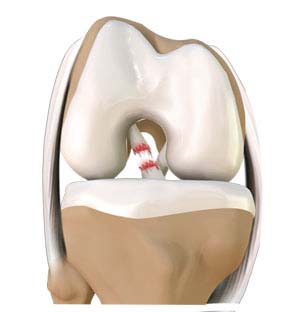
The anterior cruciate ligament (ACL) is a ligament that provides stability, reduces stress and prevents the knee from rotating or slipping out of position while jumping, running and landing. This ligament can tear during sports activities and exercise, as a result of a non-contact twisting injury, and is becoming a common injury in children.
Symptoms
Symptoms include hearing a popping sound in the knee at the time of an ACL tear, pain especially while trying to put weight on the injured leg, swelling and a feeling of instability or “giving way" with weight bearing.
Treatment
Treatment usually involves surgery as conservative treatment, including bracing and strengthening exercises, have generally shown poor results. Surgical treatment in the form of reconstruction is associated with its own challenges. A child is considered skeletally immature as their bones are still growing. The ends of each bone have a region known as the epiphysis or growth plate and are the weakest part of the knee. A traditional ACL tear repair involves the drilling of tunnels into the thigh and shin bones at the knee joint to replace the damaged ACL with graft tissue. With the growth plate in the path of these drill holes, the traditional reconstruction procedure may lead to growth abnormalities such as unequal lengths of the two legs. The younger the child, the more severe the deformity.
To lower the possibilities of growth arrest, alternative surgical techniques have been designed. One procedure involves drilling holes that go around the growth centers instead of passing through the growth centers. Another procedure involves avoiding holes altogether and wrapping the graft around the bones instead.
To reduce your chances of ACL tears, wear proper protection and techniques while playing sports or exercising.
Related Topics:
- Knee Pain
- Knee Sprain
- ACL Tears
- Meniscal Tears
- Patellar Instability
- Chondromalacia Patella
- Jumper's Knee
- Kneecap Bursitis
- Baker's Cyst
- Iliotibial Band Syndrome
- Lateral Patellar Compression Syndrome
- Fractures of the Tibia
- Osteochondritis Dissecans of the Knee
- Pediatric ACL Tears
- Shin Splints
- Knee Injury
- Unstable Knee
- Goosefoot Bursitis of the Knee
- MCL Tears
- MCL Sprains
- Meniscal Injuries
- Fractures of the Patella
- Ligament Injuries
- Multiligament Knee Injuries
- Multiligament Instability
- Knee Arthritis
- PCL Injuries
- Chondral or Articular Cartilage Defects
- Patellofemoral Instability
- Patella Fracture
- Recurrent Patella Dislocation
- Quadriceps Tendon Rupture
- Patellar Tendon Rupture
- Lateral Meniscus Syndrome
- Tibial Eminence Spine Avulsion Fracture
- Posterolateral Instability
- Osteonecrosis of the Knee
- Knee Angular Deformities
- Osteochondral Defect of the Knee
- Medial Gastrocnemius Strain
- Articular Cartilage Injury
- Loose Bodies in the Knee
- Knee Fracture
- Knee Osteoarthritis
- Knee Sports Injuries
- Patellar Tendinitis
- Pediatric Tibial Tubercle Fractures
- Women and ACL Injuries
- Medial Meniscus Syndrome
- Adolescent Knee Problems
- Anterior Knee Pain
- Runner's Knee
- Osgood-Schlatter Disease
- Patellar Dislocation/Patellofemoral Dislocation

